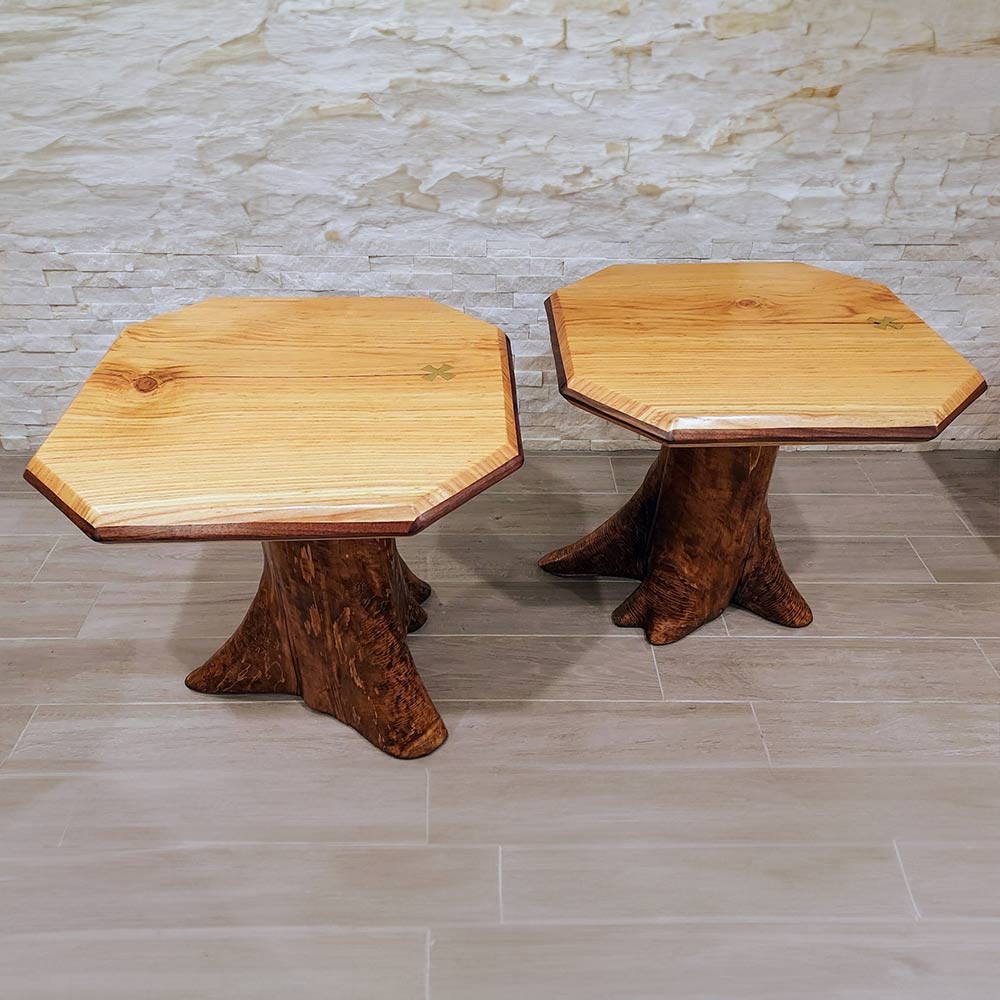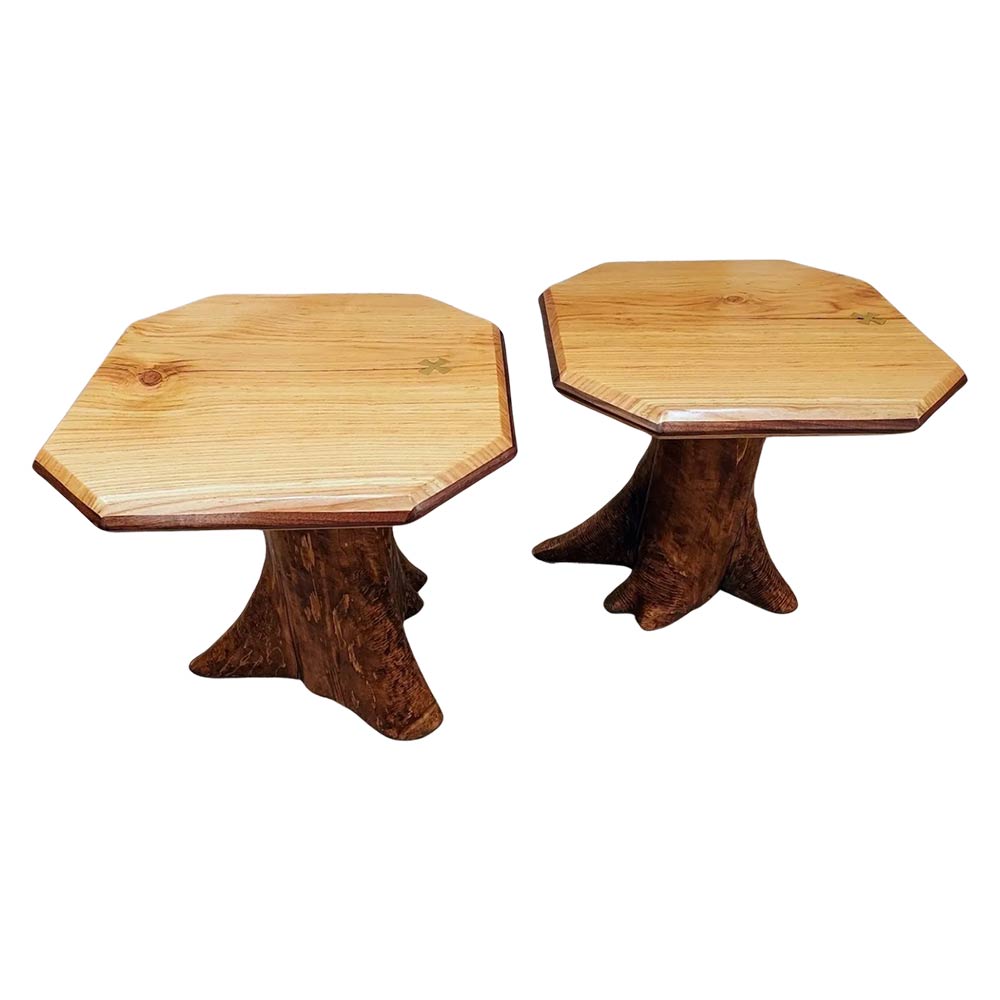Additional information
| Dimensions | 24 × 24 × 22 in |
|---|
Pair of custom wood side tables – “The Mushrooms.”
Dimensions: 24×24″ tops, 22″ tall
Tops are Honey Locust rimmed with Black Walnut. Each top also has a brass cross inlay.
Bases are live edge trunks of White Cedar with a dark stain.
Auction Ended
Item condition: New
| Dimensions | 24 × 24 × 22 in |
|---|
Auction has finished
Auction failed because there were no bids| May 1, 2024 12:00 am | Auction started | ||
Myers’ Cocktail
A Myers’ cocktail is an increasingly popular intravenous therapy. The late John Myers, MD, was the first to introduce this vitamin and mineral treatment. He designed this formula to potentially treat several clinical conditions including fatigue, fibromyalgia, muscle spasms, and many more.
Although the original Myers’ cocktail may work for many ailments, healthcare providers often tailor similar treatments for their patients to meet their specific needs.
The standard Myers’ cocktail includes:
Other ingredients may also be included, depending on the type of infusion a patient is receiving. Although this cocktail is made with generally safe components, medical providers should consider underlying conditions when treating patients. Healthcare providers often increase, decrease, add, or exclude certain vitamins and minerals to create a focused treatment for their patient’s specific goals.
A revised formulation of the Myers’ cocktail may include:[2]
A common booster used to accompany IV infusions is a potent antioxidant, glutathione. Glutathione may aid in disease prevention, immune function and energy levels.
When asked who should consider a Myers’ cocktail infusion, there is no single answer. Because of the high dose of antioxidants, nutrients, and other immune-boosting factors, individuals who have weakened immune systems or diseases that negatively impact immune resilience may benefit from receiving a Myers’ cocktail IV treatment.
Studies have found the Myers’ cocktail may be benefit patients who:
According to Myers’ cocktail studies and reviews, since the cocktails are made of vitamins and minerals, they tend to be well tolerated by many patients. Since treatment is administered intravenously vs. passing the digestive system, higher concentrations of the vitamins are more easily absorbed and thus bioavailable to the body.
Health benefits may come from receiving a Myers’ cocktail with for many patients.
For example, magnesium has been found to prevent or reduce asthma attacks, chronic fatigue, cardiovascular diseases, fibromyalgia, chronic sinusitis, rhinitis, upper respiratory tract infections, migraines, and more. Magnesium with vitamin B may increase the efficacy when paired together for those who suffer from cardiovascular diseases.[4]
Indications have been found that vitamin B6 (up to 50 mg per day) and B12 may relieve muscle weakness associated with hyperthyroidism. Those who suffer from acute muscle spasms, poor sleep at night, or high levels of stress, may have a magnesium deficiency and may benefit from receiving intravenous treatment to bring their magnesium levels to an optimum state.
Myers’ Cocktail can be administered in Dr. Grochowski’s Clinic (Chicago Interventional Pain Medicine) at 911 N Plum Grove Rd, Unit B, Schaumburg, IL 60173
Salt Cave
Experience the rejuvenating power of our 50-minute session, where every minute is as invigorating as three blissful days spent by the sea. Through the infusion of kinetic energy, our dry salt particles become an army, diligently aiding in the detoxification of your respiratory system. Just as the Himalayan salt contains a harmonious blend of 84 trace minerals and elements, mirroring those found within the human body, our session promises to replenish and revitalize your inner equilibrium.
Marjorie Baer
For over 45 years, Marjorie Baer has been designing modern, sculptural jewelry that appeals to a wide range of women. Each piece is hand-made by artisans in the San Francisco Bay Area from quality materials with craftsmanship and attention to detail.
Marjorie Baer jewelry has a unique look. Her designs are elegant, architectural, bold, and distinctive with easy balance, dramatic movement, and light-weight layers. She has become known over the years for her eye for mixed metals. Marjorie’s collection is comfortable and hypoallergenic to avoid irritation even on the most sensitive skin. Marjorie Baer’s jewelry is a staple for women who value unique and eye-catching pieces that compliment and enhance their own personal style.
All Marjorie Baer jewelry is made sustainably and ethically in our South San Francisco studio.
Sail on Lake Michigan
Embark on a breathtaking adventure with this exclusive opportunity to sail on the majestic waters of Lake Michigan. Picture yourself aboard a luxurious sailboat, gliding gracefully across the shimmering surface of one of North America’s Great Lakes. Feel the gentle breeze caress your skin as you bask in the beauty of the surrounding landscape. This auction offers the chance to experience the tranquility and serenity of sailing firsthand, accompanied by a seasoned captain and crew who will ensure your safety and comfort throughout the journey. Whether you’re seeking a romantic escapade, a family outing, or simply a peaceful retreat into nature, this sail on Lake Michigan promises an unforgettable experience filled with awe-inspiring vistas and cherished memories. Bid now to seize this extraordinary opportunity and set sail on an adventure of a lifetime.
Morning
Leon Granacki’s favorite outdoor scenes were of rippling Minnesota streams, towering pine trees, and flocks of Canadian geese. His watercolors were exhibited widely and sold at local art fairs from the 1970s through 1990.
An Artist Goes to War: Leon Granacki in the South Pacific WWII
Like so many others who served in World War II, Leon Granacki was an ordinary guy from a working-class immigrant family drafted into the US Army and thrust into the horrors of war in the South Pacific. But through sheer luck and pluck, he leveraged his art talents to survive and thrive, catapulting himself from private infantryman to Master Sergeant and mapmaker for General MacArthur in the Americal Division’s Intelligence section. Inspired by the Southern Cross as his troop transport crossed the equator, he designed the Americal Division patch for the Army’s only named division, created in New Caledonia. Overseas for three-and-a-half years without any stateside furlough, he labored over maps of enemy positions in a primitive tent in the steamy, mosquito-infested jungles of Guadalcanal and Bougainville.
In An Artist Goes to War, author Victoria Ann Granacki paints a portrait of her father, Leon, through his original maps, jungle watercolors, journal illustrations, scrapbook photos, and letters home to “Dear Gang”—his extended Polish American family crowded together in a Chicago “six-flat” apartment building. Despite only slyly alluding to awful conditions to evade the censors’ scissors, his indomitable optimism always comes through. The Polish-language letters directed to his beloved parents are filled with childlike tenderness as he tries to reassure them he’ll be safe. His plaintive longings for family, holidays home, fishing, and a woman to love are poignant reminders of the personal effects of war on reluctant soldiers.



